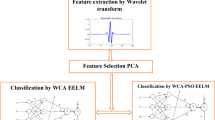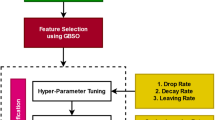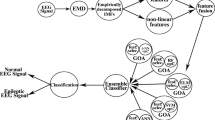Abstract
The neurological disorder named Epilepsy is diagnosed through visual inspection and manual understanding based on the Electroencephalogram (EEG) signals. Several improvements in the deep learning methods result in solving the complex problem by end to end learning. However, the current deep learning models have not utilized the EEG data for seizure detection. The main intention of this paper is to develop novel seizure detection in EEG signal using a new feature extraction and classification approaches. The first phase of the proposed model is pre-processing of signal. Further, the combination of Empirical Mode Decomposition (EMD) and Discrete Wavelet Transform (DWT) is performed for the signal decomposition. Then, the feature selection is done by the concatenation of Principal Component Analysis (PCA) and Linear Discriminant Analysis (LDA). With this selected features, an enhancement is introduced with the weighted feature selection approach, in which the weight is optimized by the hybrid meta-heuristic algorithm named Jaya-Cat Swarm Optimization (J-CSO).This hybrid meta-heuristic algorithm is easy to implement with no algorithm-specific parameters dependence. It is it easily applicable to real-world optimization problems. Due to these advantages, the performance of the proposed model is superior to the conventional models. Then, the J-CSO-based heuristically Improved Ensemble Learning Model (I-ELM) is introduced in the detection phase, which is proposed by three different classifiers like Fuzzy classifier, Deep Neural Network (DNN), and Long Short Term Memory (LSTM). This is comparable to the accuracy achieved by other contemporary seizure classification approaches, and this approach could serve as an effective tool in the hands of medical practitioners for analyzing bulk data and for speeding up seizure diagnosis.















Similar content being viewed by others
References
Abdelhameed, A.M., Bayoumi, M.: Semi-supervised EEG signals classification system for epileptic seizure detection. IEEE Signal Process. Lett. 26(12), 1922–1926 (2019)
Abdelhameed, A.M., Daoud, H.G., Bayoumi, M.: Deep convolutional bidirectional LSTM recurrent neural network for epileptic seizure detection. In: IEEE international new circuits and systems conference (NEWCAS), pp. 139–143, 2018
Acharya, U.R., Oh, S.L., Hagiwara, Y., Tan, J.H., Adeli, H.: Deep convolutional neural network for the automated detection and diagnosis of seizure using EEG signals. Comput. Biol. Med. 100, 270–278 (2018)
Akyol, K.: Stacking ensemble based deep neural networks modeling for effective epileptic seizure detection. Expert Syst. Appl. 148, 113239 (2020)
Atal, D.K., Mukhtiar, S.: A hybrid feature extraction and machine learning approaches for epileptic seizure detection. Multidimens. Syst. Signal Process. 31, 503–525 (2020)
Bouzidi, A., Riffi, M.E., Barkatou, M.: Cat swarm optimization for solving the open shop scheduling problem. J. Ind. Eng. Int. 15, 367–378 (2019)
Burrello, A., Benatti, S., Schindler, K., Benini, L., Rahimi, A.: An ensemble of hyperdimensional classifiers: hardware-friendly short-latency seizure detection with automatic iEEG electrode selection. IEEE J. Biomed. Health Inform. 25(4), 935–946 (2021)
Chen, D., Wan, S., Bao, F.S.: Epileptic focus localization using discrete wavelet transform based on interictal intracranial EEG. IEEE Trans. Neural Syst. Rehabil. Eng. 25(5), 413–425 (2017)
Chen, Z., Lu, G., Xie, Z., Shang, W.: A unified framework and method for EEG-based early epileptic seizure detection and epilepsy diagnosis. IEEE Access 8, 20080–20092 (2020)
Dissanayake, T., Fernando, T., Denman, S., Sridharan, S., Fookes, C.: Deep learning for patient-independent epileptic seizure prediction using scalp EEG signals. IEEE Sens. J. 21(7), 9377–9388 (2021)
Duanpo, Wu., Wang, Z., Jiang, L., Dong, F., Xunyi, Wu., Wang, S., Ding, Y.: Automatic epileptic seizures joint detection algorithm based on improved multi-domain feature of cEEG and spike feature of aEEG. IEEE Access 7, 41551–41564 (2019)
Fraiwan, L., Alkhodari, M.: Classification of focal and non-focal epileptic patients using single channel EEG and long short-term memory learning system. IEEE Access 8, 77255–77262 (2020)
Geng, M., Zhou, W., Liu, G., Li, C., Zhang, Y.: Epileptic seizure detection based on stockwell transform and bidirectional long short-term memory. IEEE Trans. Neural Syst. Rehabil. Eng. 28(3), 573–580 (2020)
Gupta, A., Rai, A.A.B.: Feature extraction of intra-pulse modulated LPI waveforms using STFT. In: 2019 4th International conference on recent trends on electronics, information, communication and technology (RTEICT), pp. 742–746, 2019
Hanosh, O., Ansari, R., Younis, K., Cetin, A.E.: Real-time epileptic seizure detection during sleep using passive infrared sensors. IEEE Sens. J. 19(15), 6467–6476 (2019)
Houssein, E.H., Saber, E., Ali, A.A., Wazery, Y. M.: Opposition-based learning tunicate swarm algorithm for biomedical classification. In: 2021 17th International Computer Engineering Conference (ICENCO), pp. 1–6 (2021)
Hu, D., Cao, J., Lai, X., Wang, Y., Wang, S., Ding, Y.: epileptic state classification by fusing hand-crafted and deep learning EEG features. IEEE Trans. Circuits Syst. II Express Briefs 68(4), 1542–1546 (2021)
Hussein, R., Palangi, H., Ward, R.K., Wang, Z.J.: Optimized deep neural network architecture for robust detection of epileptic seizures using EEG signals. Clin. Neurophysiol. 130(1), 25–37 (2019)
Jaiswal, A.K., Banka, H.: Local pattern transformation based feature extraction techniques for classification of epileptic EEG signals. Biomed. Signal Process. Control 34, 81–92 (2017)
Jha, C.K., Kolekar, M.H.: Empirical mode decomposition and wavelet transform based ECG data compression scheme. IRBM 42, 65–72 (2020)
Kadrolkar, A., Frank, C.: Intent recognition of torso motion using wavelet transform feature extraction and linear discriminant analysis ensemble classification. Biomed. Signal Process. Control 38, 250–264 (2017)
Li, Y., Wang, X.-D., Luo, M.-L., Li, K., Yang, X.-F., Guo, Q.: Epileptic seizure classification of EEGs using time-frequency analysis based multiscale radial basis functions. IEEE J. Biomed. Health Inform. 22(2), 386–397 (2018)
Li, Y., Liu, Y., Cui, W.-G., Guo, Y.-Z., Huang, H., Hu, Z.-Y.: Epileptic seizure detection in eeg signals using a unified temporal-spectral squeeze-and-excitation network. IEEE Trans. Neural Syst. Rehabil. Eng. 28(4), 782–794 (2020)
Liu, Y., Huang, Y.-X., Zhang, X., Qi, W., Guo, J., Yingbai, Hu., Zhang, L., Hang, Su.: Deep C-LSTM neural network for epileptic seizure and tumor detection using high-dimension EEG signals. IEEE Access 8, 37495–37504 (2020)
Nakisa, B., Rastgoo, M.N., Rakotonirainy, A., Maire, F., Chandran, V.: Long short term memory hyperparameter optimization for a neural network based emotion recognition framework. IEEE Access 6, 49325–49338 (2018)
Niknazar, M., Mousavi, S.R., Vahdat, B.V., Sayyah, M.: A new framework based on recurrence quantification analysis for epileptic seizure detection. IEEE J. Biomed. Health Inform. 17(3), 572–578 (2013)
Orhan, U., Hekim, M., Ozer, M.: EEG signals classification using the K-means clustering and a multilayer perceptron neural network model. Expert Syst. Appl. 38(10), 13475–13481 (2011)
Rabcan, J., Levashenko, V., Zaitseva, E., Kvassay, M.: Review of methods for EEG signal classification and development of new fuzzy classification-based approach. IEEE Access 8, 189720–189734 (2020)
Rao, R.V.: Jaya: a simple and new optimization algorithm for solving constrained and unconstrained optimization problems. Int. J. Ind. Eng. Comput. 7, 19–34 (2016)
Rashed-Al-Mahfuz, M., Moni, M.A., Uddin, S., Alyami, S.A., Summers, M.A., Eapen, V.: A deep convolutional neural network method to detect seizures and characteristic frequencies using epileptic electroencephalogram (EEG) data. IEEE J. Transl. Eng. Health Med. 9, 1–12 (2021)
Salem, O., Alsubhi, K., Mehaoua, A., Boutaba, R.: Nocturnal epileptic seizures detection using inertial and muscular sensors. IEEE Trans. Mobile Comput. 18(12), 2913–2925 (2019)
Sam, L.Z., Maarof, M.A., Selamat, A.: Automated web pages classification with integration of principal component analysis (PCA) and independent component analysis (ICA) as feature reduction. In: Proceedings of international conference on man-machine systems, 2006
Tian, X., et al.: Deep multi-view feature learning for EEG-based epileptic seizure detection. IEEE Trans. Neural Syst. Rehabil. Eng. 27(10), 1962–1972 (2019)
Verma, S., Kaur, S., Rawat, D.B., Xi, C., Alex, L.T., Jhanjhi, N.Z.: Intelligent framework using IoT-based WSNs for wildfire detection. IEEE Access 9, 48185–48196 (2021)
Xu, S.S., Mak, M.-W., Cheung, C.-C.: I-vector-based patient adaptation of deep neural networks for automatic heartbeat classification. IEEE J. Biomed. Health Inform. 24(3), 717–727 (2020)
Yavuz, E., Kasapbaşı, M.C., Eyüpoğlu, C., Yazıcı, R.: An epileptic seizure detection system based on cepstral analysis and generalized regression neural network. Biocybern. Biomed. Eng. 38(2), 201–216 (2018)
Yuan, Y., Xun, G., Jia, K., Zhang, A.: A multi-context learning approach for EEG epileptic seizure detection. BMC Syst. Biol. 12, 107 (2018)
Yuan, Y., Xun, G., Jia, K., Zhang, A.: A multi-view deep learning framework for eeg seizure detection. IEEE J. Biomed. Health Inform. 23(1), 83–94 (2019)
Zhang, X., Yao, L., Dong, M., Liu, Z., Zhang, Y., Li, Y.: Adversarial representation learning for robust patient-independent epileptic seizure detection. IEEE J. Biomed. Health Inform. 24(10), 2852–2859 (2020)
Author information
Authors and Affiliations
Corresponding author
Additional information
Publisher's Note
Springer Nature remains neutral with regard to jurisdictional claims in published maps and institutional affiliations.
Rights and permissions
About this article
Cite this article
Bhandari, V., Huchaiah, M.D. A new design of epileptic seizure detection using hybrid heuristic-based weighted feature selection and ensemble learning. Int J Intell Robot Appl 6, 668–693 (2022). https://doi.org/10.1007/s41315-022-00233-3
Received:
Accepted:
Published:
Issue Date:
DOI: https://doi.org/10.1007/s41315-022-00233-3




